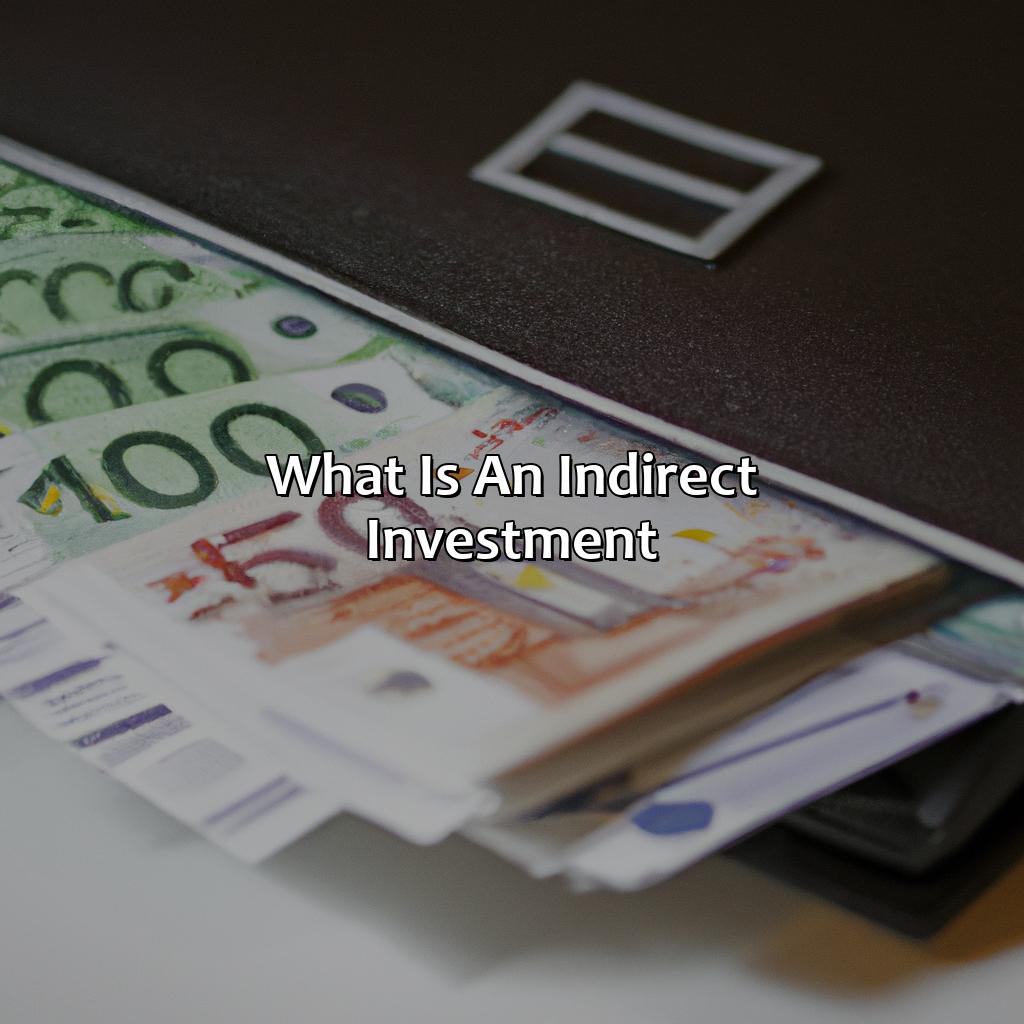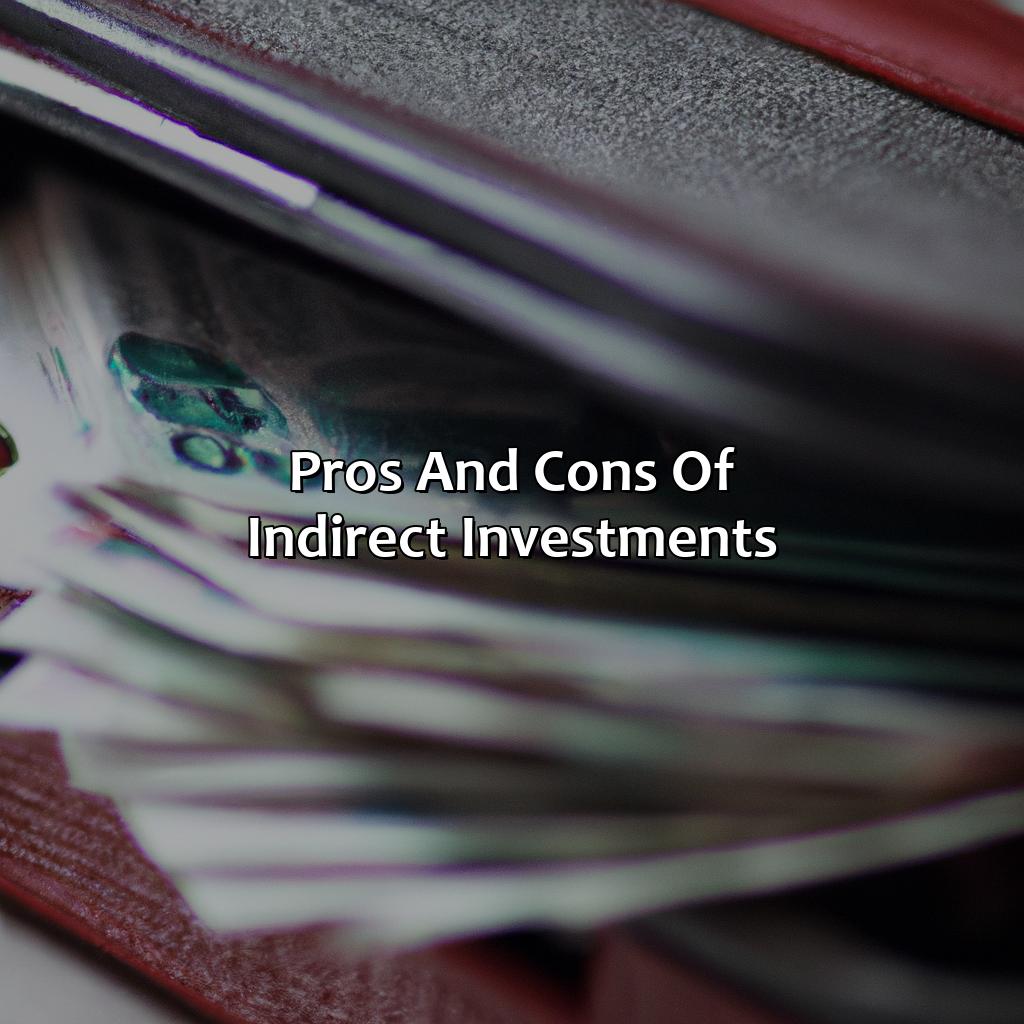What Is An Indirect Investment?
Key Takeaway:
- Indirect investment refers to investing in assets that do not involve direct ownership, but instead involve investing in a company or entity that owns the assets. This allows investors to diversify their portfolio and gain exposure to assets that they may not have been able to afford or access otherwise.
- There are several types of indirect investments, including mutual funds, exchange-traded funds (ETFs), real estate investment trusts (REITs), and hedge funds. Each type offers different levels of risk and return, and investors should carefully consider their goals and risk tolerance before investing.
- Examples of indirect investments include investing in a mutual fund that holds stocks, investing in an ETF that tracks a specific industry or sector, or investing in a REIT that owns and manages real estate properties.
- Advantages of indirect investments include diversification, professional management, and potentially higher returns. Disadvantages include fees, lack of control over the assets, and potential for volatility.
Investing can be intimidating. But you don’t need to be an expert to start growing your wealth. An indirect investment, like an ETF, can provide you with a simple and low-cost way to begin investing. Learn what an indirect investment is now.
What is an indirect investment?
Gain insight on indirect investment by exploring its definition. It’s an investment of money in assets, not individual ones. Check out different types, such as mutual funds and exchange-traded funds. This can help you decide which one is best for your financial goals.
Examples of indirect investments let you see the risks and rewards.

Image credits: retiregenz.com by Harry Woodhock
Definition of indirect investment
Indirect investment refers to investing in a company through a third-party intermediary such as mutual funds, exchange-traded funds, or hedge funds. The investor does not directly own the assets but has exposure to them through the intermediary.
Such investments offer diversification and professional management services, making it accessible for retail investors to invest in various asset classes such as real estate, commodities and stocks with lower transaction costs. This type of investment can have varying degrees of risk depending on factors like the type of asset class and economic conditions of the country.
It is essential to understand that indirect investments are subject to the risks associated with both the intermediary’s performance and market volatility. Therefore, investors need to research their intermediaries carefully before making any investments.
Pro Tip: Before making an indirect investment, check for performance reports, investment strategies history and portfolio holdings of the intermediary you opt for.
Why invest in stocks directly when you can do it indirectly and blame your losses on someone else?
Types of indirect investments
Indirect investments are those in which you don’t hold the asset directly, but rather invest in a vehicle that holds multiple assets. There are various types of these investments with different characteristics. Here is an overview of some common types:
| Name | Description | Examples |
|---|---|---|
| Mutual Funds | Pooled money from multiple investors used to purchase a portfolio of assets managed by professionals. | Fidelity Magellan Fund, Vanguard 500 Index Fund |
| Exchange-Traded Funds (ETFs) | Similar to mutual funds but traded on stock exchanges like individual stocks. | SPDR S&P 500 Trust, iShares Russell 2000 ETF |
| Real Estate Investment Trusts (REITs) | Own and operate income-generating real estate properties such as apartments, malls, and office buildings. Investors receive dividends based on rental income and property value appreciation. | Simon Property Group, Equity Residential |
| Hedge Funds | Alternative investment vehicles open only to accredited investors due to their complexity and high fees. Their goal is to generate higher returns through active trading strategies not typically used by mutual funds or ETFs. | Bridgewater Associates, Renaissance Technologies |
It’s important to note that indirect investments may have lower transparency and higher fees than direct investments, but they provide diversification benefits and access to specialized markets.
An interesting fact is that according to a survey conducted by the Investment Company Institute in 2020, the total assets under management for mutual funds surpassed $22 trillion globally.
Indirect investments are like blind dates – you don’t know what you’re getting into until it’s too late, but sometimes it pays off.
Examples of indirect investments
Indirect investments are investments that provide a means for investors to invest in an asset without actually owning it. This approach has become quite popular in recent years as people seek to diversify their investment portfolios and reduce risk.
Here are five examples of indirect investments:
- Exchange-traded funds (ETFs)
- Mutual funds
- Real estate investment trusts (REITs)
- Private equity funds
- Hedge funds
One unique aspect of indirect investments is that they allow investors to gain exposure to a diverse group of assets with just one investment. This not only simplifies the investment process, but it also helps reduce risk by spreading invested capital across multiple assets.
In the early 2000s, institutional investors began investing in private equity and hedge funds as a way to diversify their portfolios and enhance returns. Today, individual investors have access to these types of investments through various financial products like mutual funds and ETFs. Indirect investments have become an essential tool for anyone wanting to allocate their portfolio effectively while minimizing risk.
Indirect investments: like playing a game of telephone, but with your money.
Pros and cons of indirect investments
Weigh the pros and cons of indirect investments. To make smart financial decisions, look into the advantages and disadvantages. Check out the opportunities and risks of these investments in the following sections:
- Benefits of Indirect Investments
- Drawbacks of Indirect Investments

Image credits: retiregenz.com by James Washington
Advantages of indirect investments
Indirect investments offer numerous benefits to investors. These include minimal risk, portfolio diversification, and access to professional management, among others. By investing in asset managers, mutual funds or exchange-traded funds (ETFs), investors can enjoy benefits such as reduced transaction costs and lower minimum investment requirements.
Moreover, indirect investments provide significant geographic exposure to investors in regions where direct investment is difficult or costly. As a result, international investors benefit from broadening their portfolios by investing in emerging markets indirectly and avoiding currency risks.
Overall, indirect investments enable investors to invest in multiple assets with ease and opportunity for better performance. For instance, Jim invested in cryptocurrency index funds and got better returns.
It’s like getting a blind date for your money, with all the risks and none of the fun.
Disadvantages of indirect investments
Indirect investments bring certain drawbacks to investors that should be considered before making any investment decisions. These drawbacks can affect an investor’s returns and capital growth over time.
- Limited control over the investment: Investing indirectly means entrusting your money to someone else who will make the key decisions. This limitation on control is likely to result in a mismatch between an individual investor’s preference, goals, and risk tolerance.
- Higher costs: Indirect investments typically involve a number of parties such as brokers, advisors, and fund managers, all of which take a portion of returns. Consequently, management fees can grow quickly and become expensive over time.
- Lack of transparency: An indirect investor does not enjoy any visibility or say into the underlying assets included in their portfolio. This lack of visibility risks compromising confidence in the investment process.
- Less flexible access: Withdrawals from indirect investments may take longer compared to direct investments, sometimes several months or even years.
- Macro events’ influence on asset classes: Market volatility can sway specific asset classes throughout securitized indirect investments implemented by one of many third-party agents.
It is important to recognize that other disadvantages associated with indirect investing do exist.
Diversifying across markets globally through index funds leverage a subtle distinction among assets whose performance human managers might easily manipulate for losses were they anticipating markdowns substantial enough to threaten company health. In fact, research has found that around 85% percent of professional stock mutual fund managers failed to beat the market indexes over a 15-year span.
Some Facts About Indirect Investment:
Indirect investment involves investing in assets such as stocks, bonds, and mutual funds without directly owning them. (Source: Investopedia)
Indirect investment provides investors with diversification and professional management of the assets. (Source: The Balance)
Examples of indirect investments include exchange-traded funds (ETFs) and index funds. (Source: NerdWallet)
Indirect investment allows for easy and cost-effective access to various markets and sectors. (Source: MoneyUnder30)
Risks associated with indirect investment include market volatility, management fees, and lack of control over the underlying assets. (Source: Forbes)
FAQs about What Is An Indirect Investment?
What is an indirect investment?
An indirect investment refers to an investment in which an individual invests in the securities of a company that invests in another company or multiple companies. The investor does not directly own the assets but owns shares in the intermediary company, which gives them exposure to the underlying assets.
What are the benefits of an indirect investment?
One of the benefits of an indirect investment is that it allows for diversification without having to commit a large amount of capital. Indirect investments also provide access to markets and assets that may be difficult for an individual to access otherwise.
What are some examples of indirect investments?
There are many ways to make an indirect investment, such as mutual funds, exchange-traded funds (ETFs), hedge funds, private equity funds, and real estate investment trusts (REITs).
How are indirect investments managed?
Indirect investments are managed by fund managers who make investment decisions on behalf of the investors. The fund managers use their expertise to identify promising industries, companies, or assets to invest in, with the aim of generating returns for their investors.
What are the risks associated with indirect investments?
Like any investment, indirect investments come with their fair share of risks. These risks may include market volatility, liquidity risks, interest rate risks, and inflation risks. Investment in any particular asset class, fund, or company also carries unique risks.
What should I consider before making an indirect investment?
Before making an indirect investment, it’s important to understand the investment’s risks and potential returns. Consider factors such as fees, quality of the fund or company, historical returns, and the fund manager’s track record. It’s also important to have a clear investment objective and risk tolerance in mind. It’s advisable to seek the advice of a financial advisor before making any investment decision.
 Checkout this IRS Loophole
Checkout this IRS Loophole 
